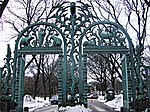Bronx Park

Bronx Park is a public park along the Bronx River, in the Bronx, New York City. The park is bounded by Southern Boulevard to the southwest, Webster Avenue to the northwest, Gun Hill Road to the north, Bronx Park East to the east, and East 180th Street to the south. With an area of 718 acres (2.91 km2), Bronx Park is the eighth-largest park in New York City. Founded in the late 1880s, Bronx Park is the location of the New York Botanical Garden and the Bronx Zoo, which respectively occupy much of the northern and southern portions of the park. Fordham Road runs east-west between the zoo and botanical garden, bisecting Bronx Park, while the Bronx River Parkway runs north-south near the eastern edge. The park is operated by the New York City Department of Parks and Recreation.
Excerpt from the Wikipedia article Bronx Park (License: CC BY-SA 3.0, Authors, Images).Bronx Park
Conservatory Drive, New York The Bronx
Geographical coordinates (GPS) Address Nearby Places Show on map
Geographical coordinates (GPS)
| Latitude | Longitude |
|---|---|
| N 40.856388888889 ° | E -73.876666666667 ° |
Address
New York Botanical Garden
Conservatory Drive
10458 New York, The Bronx
New York, United States
Open on Google Maps







